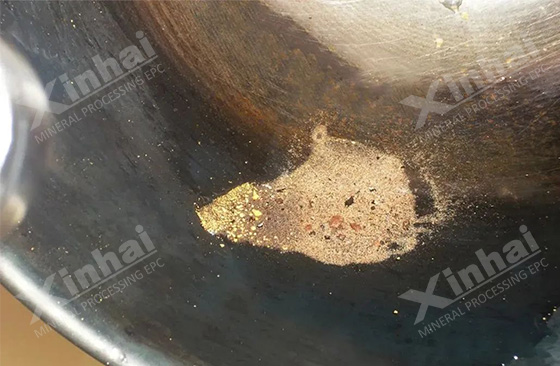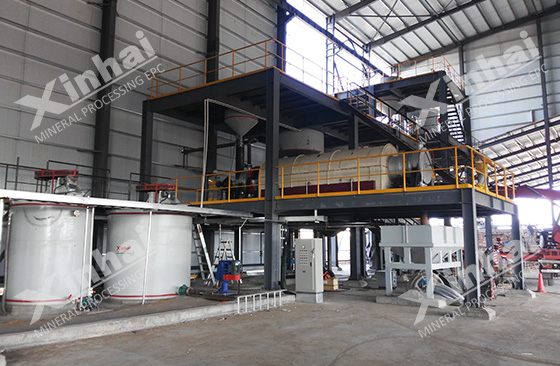
As the price of gold continues to rise, the beneficiation and processing of gold ore is receiving more and more attention, because gold mines are the main source of gold. The extraction and craftsmanship of gold particles from gold mines drives every stage in the beneficiation process, from mining, crushing, grinding, thickening and dewatering to gold recovery.
In actual gold recovery production, there are many processing methods for gold minerals, such as cyanidation, flotation, and gravity separation. These technologies are the basic technologies for mineral processing plants to extract gold from different types and grades of gold deposits.
Of course, there are other Mineral processing technology. Reasonable gold ore beneficiation technology needs to be determined based on the type, form and other factors of the ore. The form and characteristics of gold in the ore will affect the economics of the beneficiation project, which will in turn affect the investment decision of the overall project, the selection of processing technology and the overall project Profitability.
The following will introduce the basic types of gold ore and common beneficiation methods to help you understand the gold beneficiation.
Gold ore exists in various forms and compositions, each with its own characteristics. The following are common types of gold ore:

1. Free gold: Gold particles can be observed in the ore and are easily separated from the surrounding gangue minerals. They are generally easier to process and extract gold from than other types of ores.
2. Refractory gold ore: Refractory gold ore contains gold that is difficult to extract. The gold particles are wrapped in minerals such as pyrite, arsenopyrite or telluride. When these ores are processed, specialized processes such as roasting, pressure oxidation, or bioleaching are required to release the gold from these ores.
3. Sulfide gold ore: In addition to gold, sulfide gold ore also contains pyrite (iron sulfide) or arsenopyrite (arsenic sulfide), these sulfide minerals. Extracting gold from sulfide ore usually involves complex chemical processes, such as flotation or cyanide.
4. Oxidized gold ore: As oxidized gold ore is weathered near the surface, native sulfide minerals are converted into oxides and hydroxides. They may contain gold in oxide, hydroxide or carbonate minerals such as hematite, goethite or limonite.
5. Telluride Gold Minerals: Telluride minerals, such as anorthite, potassium feldspar, or potassium feldspar, contain gold combined with tellurium. Extracting gold from telluride ore can be more challenging and may require additional processing steps.
6. Carbonaceous gold ore: Carbonaceous gold ore contains organic carbon, which can adsorb gold during the cyanidation process and reduce the gold recovery rate. Special treatment methods, such as CIL or CIP, can be used to solve this problem.

7. Placer gold deposits: Placer gold deposits are formed by the erosion and concentration of gold particles in the sand of rivers, streams or beaches. These deposits typically contain gold nuggets or flakes and are typically extracted through placer mining techniques such as gold panning, flushing, or dredging.
These are just a few of the common gold ores, and each ore of gold requires specific processing methods and technologies to extract gold efficiently and economically.
The choice of a gold ore beneficiation process depends on a variety of factors, including ore type, mineralogy, the presence of other valuable minerals, and economic and environmental considerations. Here are some common beneficiation processes used for different types of gold ore:

1. Gravity separation: Equipment commonly used in gravity separation technology include jigs, shakers and centrifugal concentrators, which are usually used to recover coarse gold from free gold and placer ores. This method mainly exploits the density difference between gold particles and gangue minerals.
2. Flotation: Flotation is commonly used to recover gold from sulfide ores, including refractory ores. In this process, finely ground ore is mixed with water and flotation reagents such as collectors and frothers to selectively separate gold-bearing sulfide minerals from gangue.
3. Cyanidation: Cyanidation or leaching using cyanide is a widely used method of extracting gold from ores containing free gold particles or fine disseminated gold. The gold is dissolved into a cyanide solution and then recovered by adsorption onto activated carbon or by precipitation with zinc or other metals.

4. Roasting: Roasting is often used to process refractory gold ores containing sulfide minerals. In this process, the ore is heated in the presence of air or oxygen to oxidize the sulfide minerals and release the encapsulated gold. The roasted ore can then be subjected to cyanidation or other leaching methods.
5. Pressurized oxidation: Pressurized oxidation is a high-temperature and high-pressure process used to treat refractory gold ores containing sulfide minerals. The ore is treated with oxygen and sulfuric acid at high temperatures, oxidizing the sulfide minerals and releasing the gold for subsequent cyanidation.
6. Bioleaching: Bioleaching uses microorganisms to extract gold from sulfide and refractory ores. Certain bacteria and fungi catalyze the oxidation of sulfide minerals, releasing gold into solution for recovery.
7. Carbon leaching (CIL)/carbon slurry (CIP): These two processes are used to recover gold from carbonaceous gold ores or gold ores containing organic carbon. The ore is ground and mixed with a cyanide solution, then passed through a carbon column where the gold is adsorbed onto the activated carbon. Heat or chemicals are then used to strip the gold from the loaded carbon.

How to Choose the Right Gold Beneficiation Method?
Types of Gold Ores | Gold Beneficiation Process | Characteristics and Considerations |
Free gold | Gravity Separation , Amalgamation or Gravity Separation + Cyanidation, | Low cost, high efficiency, suitable for rapid recovery of coarse-grained gold |
Refractory gold ore | Pretreatment + Cyanidation (CIL/CIP) | Complex process, large investment, but can effectively improve the dissociation rate of gold |
Sulfide gold ore | Flotation + Oxidative Processing + Cyanidation | High flotation rate, need to be two-stage treatment to enhance the recovery |
Oxidized gold ore | Heap Leaching, CIL/CIP | Easily selectable and easy to leach, good economy |
Telluride gold minerals | Frothing + Cyanidation, Chlorination, Flotation + Metallurgy | High technical difficulty, gold extraction requires special treatment |
Carbonaceous gold ore | Frothing, Adsorption Control, Inclusion Controlled, Encapsulant Suppression | Avoid carbon adsorption of gold ions to improve the recovery |
Placer gold deposits | Gravity Separation, Amalgamation or Gravity Separation + Metallurgical Gold Extraction | Simple, efficient, suitable for small projects or initial recovery |
The above is a brief summary of the types of gold ore and beneficiation methods. The choice of specific beneficiation processes depends on the specific characteristics of the deposit as well as economic and environmental factors. Often, different methods can be combined to maximize gold recovery from a specific ore.
Xinhai Mining recommends conducting mineral processing tests to determine the characteristics of the ore, and designing a gold ore processing plan based on the actual mineral processing plant to improve the economic benefits of the gold mineral processing plant.
To find out more about our products and solutions, please fill out the form below and one of our experts will get back to you shortly.